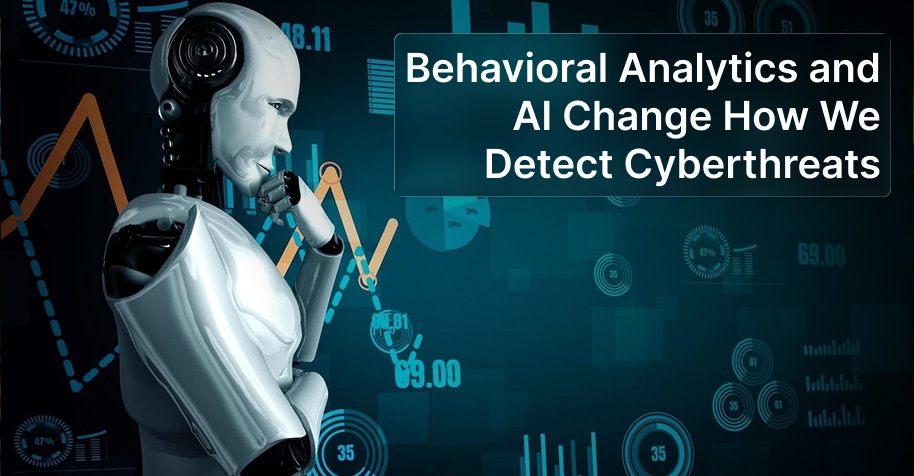
Traditional security tools are like bouncers who only recognize the known troublemakers. They’re great for stopping the usual suspects, but what about the clever, first-time problems? Behavioral analytics and AI have stepped up to solve this problem, transforming how we catch threats.
Most security setups maintain a database of known threats and cross-reference incoming activity against that list. Think of it like a bouncer at a club who only knows the regular troublemakers but what about first-time problems? Behavioral analytics takes a different approach than traditional security hunting. Someone starts doing unusual things middle-of-the-night logins, digging through files they normally ignore or shuffling data around in weird ways and boom, the system catches it.
Here’s How This Thing Works
Think about having a team member who remembers everything about how everyone works. They know exactly how every single employee operates. When someone starts acting weird logging in at strange hours, accessing files they’ve never touched or moving data in unusual patterns the system notices.
We’re not talking about keyloggers or reading your emails. This is all about watching activity patterns. The system gets to know everyone’s work style, which apps they love, when they’re busiest, how they like to navigate around and their typical data habits. It’s like creating a digital DNA profile for each person.
Here’s what makes this powerful: attackers might steal credentials, but they can’t steal behavior patterns. Hackers using stolen credentials behave differently from the actual user. They’ll access different files, use different applications and follow different navigation paths. Behavioral analytics catches these discrepancies.
➢ AI Is The Secret Sauce

Adding AI is like upgrading from a security guard to a team of detectives with photographic memories. Machine learning chews through tons of user data and spots threats that would slip past people every day.
Old-school systems need constant manual updates for each new threat: “Send alert when user downloads more than X files in Y minutes.” But attacks evolve faster than rule books. AI adjusts on the fly without needing someone to manually update code every time attackers change their tactics.
AI picks up on typical quirks and variations, not just problems. Maybe Sarah from accounting always works late on month-end or the development team regularly pulls large code repositories. AI separates normal unusual behavior from actual threats.
AI links behaviors across different users and systems simultaneously. Three employees browsing sensitive files outside their normal duties creates visible patterns, even when each action appears routine.
➢ Spotting Real Threats
Let’s walk through how this works in practice. Say an attacker compromises a marketing manager’s account through a phishing email. Standard security tools might miss compromises even when credentials appear valid and system access looks normal.
But behavioral analytics notices immediately. The attacker starts by exploring file shares, something this marketing manager rarely does. They access HR documents, which is completely outside normal behavior patterns. They download large amounts of data, far more than typical usage. Each action by itself might not trigger alerts, but the combination creates a clear behavioral signature.
The system connects this activity with other red flags: login from a different location, unusual browsing habits and skipping the tools this marketing person normally uses. Within minutes, the system flags this as a high-probability compromise.
This is where it gets interesting. The system adjusts its response based on how serious the threat looks. A small deviation? That just prompts some extra verification. Moderately weird stuff could block access to sensitive files. Highly suspicious stuff triggers immediate lockdowns and team alerts.
➢ Catching Advanced Persistent Threats

This is where behavioral analytics really shines. Long-term threats? Forget about it. Even if attackers move slowly and carefully, they simply can’t perfectly mimic a real user’s behavior over extended periods. Small deviations accumulate over time, creating patterns that AI can detect.
One real-world example involved an APT that had been dormant in a financial institution for eight months. The attackers used valid credentials and only accessed systems during business hours. But behavioral analytics noticed subtle differences: file access patterns that didn’t match the compromised user’s role, data queries that seemed random rather than purpose-driven and navigation paths that suggested exploration rather than specific task completion.
Also Read: The Future of AI in Consumer Financial Management
➢ Modern Malware Needs Modern Solutions
Modern malware protection approaches have had to evolve because simple signature-based detection just doesn’t cut it anymore against today’s sophisticated threats. Behavioral analytics plays a huge role in these comprehensive protection strategies by focusing on what malware does rather than what it looks like.
Fileless malware doesn’t even install traditional files that antivirus can scan. Instead, it hijacks legitimate system tools to do dirty work. Behavioral analytics catches these attacks by noticing when normal tools like PowerShell get used in weird ways.
Polymorphic malware keeps changing its code structure to dodge signature detection, but it can’t change its core behavior. It still needs to phone home to command servers, grab specific system resources and perform certain actions to achieve its goals. These behavioral fingerprints stay consistent even when the code reshuffles itself.
➢ Business Impact and ROI

Statistical evidence strongly supports behavioral analytics. Standard detection catches threats after months (280 days average) nearly a full year for damage to accumulate. Behavioral analytics can spot anomalies within hours or days, dramatically reducing the window for attackers to cause harm.
Quick detection equals reduced costs. Every day attackers stay hidden, they steal more data, damage more systems and disrupt more business operations. Companies using behavioral analytics are seeing real results: threats detected 60% faster and incident response costs down 45% compared to traditional methods.
There’s another huge win: fewer false alarms. Security teams get buried under thousands of alerts daily and most turn out to be nothing. Behavioral analytics with AI gets much better at separating real threats from noise, so your team can focus on actual problems instead of chasing ghosts.
Also Read: Maximize your Marketing ROI with Expert PPC Management Strategies
➢ Implementation Roadmap
Setting up behavioral analytics means more than installing software, you’re changing how your entire organization thinks about security. Give systems about 30-90 days to learn what normal looks like in your environment. Teams spend this period adjusting sensitivity levels and tweaking alert parameters.
Privacy concerns come up a lot, especially in companies with strict employee privacy policies. Being transparent about monitoring helps keep employees comfortable. Behavioral analytics looks at usage patterns and metadata, not actual content. It’s watching how systems get used, not snooping on what people are doing with their data.
Consider how this will connect with your existing security stack. Behavioral analytics works best as part of a comprehensive security platform, feeding data to and receiving context from other security tools. Today’s solutions come with APIs and integration options, though you’ll want to map out how everything connects before you start.
Looking Ahead: The Future of Behavioral Detection
The technology keeps getting smarter. Next-generation systems are incorporating user entity behavior analytics (UEBA) that considers broader context not just what users do, but when they do it, from where and under what circumstances.
Cloud computing is pushing behavioral analytics in new directions. Moving to the cloud makes user behavior patterns more scattered and complex. AI tracks what’s happening across all your different environments now, whether you’re running things in your own data center or out in the cloud somewhere.
The integration of threat intelligence feeds is making behavioral analytics even more powerful. Systems can now correlate detected anomalies with external threat data, providing context about attack campaigns and techniques seen elsewhere.
Don’t Bring a Knife to a Digital Gunfight
Companies still running 2015-era security might as well put up a “welcome hackers” sign. Behavioral analytics and AI aren’t experimental anymore, they’re basic cybersecurity requirements now.
Consider this perspective. Security teams waste hours sifting through false alarms from legacy tools while attackers work undetected. Attackers have improved their camouflage, they blend in better while doing damage.
Keep trying to fix what’s already failed or switch to security that actually works against current threats. Make the call, but remember that threats aren’t taking a break.
This isn’t about keeping up with the latest tech trends. We’re talking about staying relevant in a world where cybersecurity fundamentally changed, while many organizations are still operating like it’s 2015. The solutions are already out there, they work and chances are good that companies in your space are already using them.
The real question is: how long can you afford to fight tomorrow’s battles with yesterday’s weapons?






